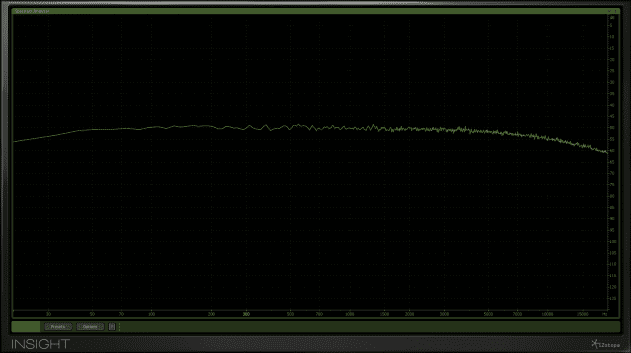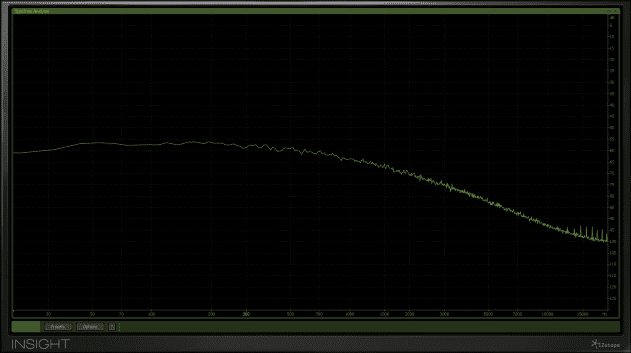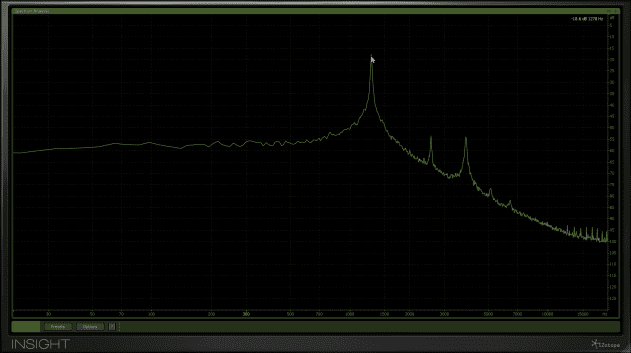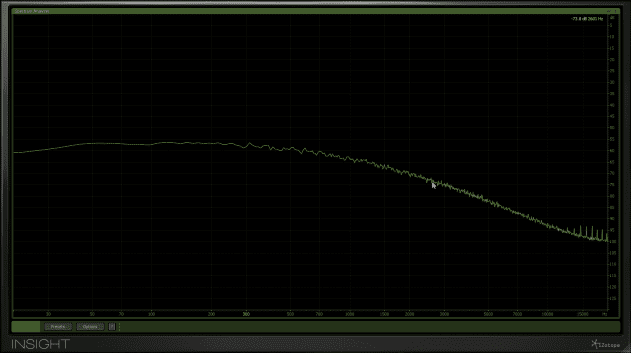Analysing the Korg MS-20
What if we don’t know much about a filter and want to work-out some of its underlying spec? Time to wheel in the white noise again, and this time we’ll use a Korg MS-20, which has two independent filters, one high-pass and one low-pass.
Bring down the low-pass filter cutoff frequency.
To find the cutoff frequency, raise the resonance and look for the ‘bump’.
Here it’s showing 1,278 Hz. Notice the smaller harmonic peaks higher up in the audio spectrum – a clear pointer that analogue filter slopes are rarely linear.
Drop the resonance down, and find the frequency point that is double that of the peak noted earlier – 1,278 x 2 = 2556. How much lower is the level at 2,556 Hz?
This will give you the amount of signal attenuation in dB/octave. So, 75 dB – 64 dB = 11 dB, giving what appears to be a slope of 11 dB/octave. Close, if not exactly equal, to the quoted MS-20 low-pass filter spec of a 12 dB/octave filter.
Determining the resonance characteristics is less of a scientific approach, and more about listening. Push the resonance right up to see what effect this has. You could see what additional gain that it adds around the peak, or whether the overall frequency balance is affected (as in the case of the TB-303, where bass frequencies are affected by increasing the resonance). When comparing filters you may also find variations in the width of the resonant hump, amongst many other subtler differences.
These basic characteristics allow us to get a good starting point for recreating a filter in software, but miss out on all the non-linear stuff that is such a crucial part of the analogue sound. This is just one of the reasons why emulating a classic synth or other analogue gear can be so tricky, but it’s also a major part of what makes filters such enduringly popular tools for shaping audio: each one has its own distinct character.





04.09 PM
Thanks !
Good basic article, but I would assume the typical reader of attack mag already pretty much knew about filter frequency charts resonance, poles, comb filters, etc.
It would have been maybe interesting after a short introduction covering these topics, to move on to discuss in more detail the phase effects of filters, the different uses and possibilities of modulations routes, what makes a moog, DSI, arturia filters, sound so different, etc…
03.35 AM
Good article! I enjoyed the example filter types (Oberheim, Korg, Moog, Arturia). I often look for ways to describe differences in filters. I also appreciated the learning that analogue filter slopes are rarely linear. Guess I’ll have to go play with Ableton Lives new Cytomic filter types.